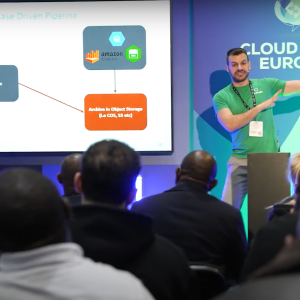
Some cloud companies were hit hard in the last week with high profile share price tumbles at Linkedin and Tableau – both lost over 40% of the value in a matter of hours.
This has led to questions being asked about whether the cloud bubble has burst.
But there is no cloud bubble. The cloud is not foggy. It is not fluffy. It is not intangible. Linkedin is a social media company built on a cloud platform, Tableau is a data visualisation tool also built on cloud. Investors judge firms on their financial performance not the platform on which they are built.
The cloud has already changed everything and is not going anywhere.
For consumers a cloudless IT world would be one without mobile banking, e-tailing and Whatsapp.
For the business world it would be one without AWS, Azure, Googlecloud, Salesforce and we could forget any notion of big data, Hadoop, Openstack and Dev Ops.
Infrastructure would still be king. We would still occupy a world where what IT provided was the equivalent of everyone being given their own school bus to drive. Very unwieldy and with loads of empty seats,
It would be a world of deploying servers months after they were requested. It would be a world of 3 year technology refreshes, chip upgrades and operating system incompatibilities dictating investments, long term depreciation considerations dictating the pace of technology investment.
It was not too long ago that a major enterprise IT issue was one of under-utilisation.
In poorly run and audited environments enterprise IT became a place where each app, not matter how insignificant was given its own stack of server, RAID and switch. It was given a place in data centre and as David Merrill, Chief Economist at Hitachi tells us, IT never again asked if it was being used, how it was being used or when it would stop being used.
Wintel were not the only ones responsible for this for the infrastructure side of this – though it didn’t help that fatter and fatter applications sat on bloated operating systems requiring ever more cycles and memory to run at all.
Software license to print money
Software licenses were used to print money. Perpetual licensing meant annual taxes, software audits meant fines. The subscription model for software use is not perfect but it is better than it was. It may not even turn out to be cheaper in the long run but it provides value beyond simply cost.
Today software delivery can happen in seconds. You no longer have to wait months for your applications to update. [Read the interview with Telefonica’s CIO]. Vendor release cycles are shorter which means new functions and features for users who aren’t stuck with an app or service they hate and doesn’t help with the job. And the chances are that you have a development team that is customising your Saas platform and that itself is acting like a cloud service provider.
Cloud spending will continue to growth. Cloud adoption will continue. Worldwide spending on public cloud services is estimated to grow by a 19.4% compound annual rate over the next four years, to $141 billion in 2019, from $70 billion in 2015,
Private, Public, Hybrid. Does it matter?
The maturity of the cloud industry will do it no favours. Investors like growth and they love profit margins. Cloud infrastructure will be a commodity and commodity yields are low.
Cloud based application software firms themselves could suffer margin erosion thanks to demands for greater transparency, dial tone computing true pay per use utility models and increased competition.
But growth will come from enterprise firms increased use of cloud. In the enterprise world more and more companies will run more and more applications on cloud platforms.
As was said recently by one UK CIO at one meeting I hosted recently: "If we came back here in five years time, no-one around this table would own any data centres, servers, storage or networking gear."
This was partly a comment on IT leader demographics – not many digital natives are yet running large enterrprise IT estates.
We often hear about traditional companies losing out to faster, more nimble, more agile firms. In IT, cloud is your basic first step to avoiding disintermediation. Cloud is shorthand for software. Software as a service, security as a service, database as a service, infrastructure as a service.
We will all be service providers accessing and providing software based outcomes and most importantly we will be speaking the language of service provision.






